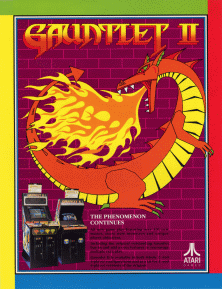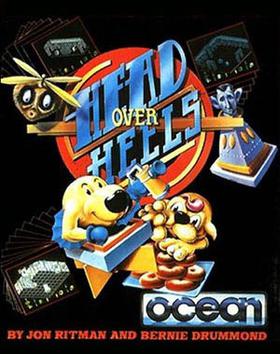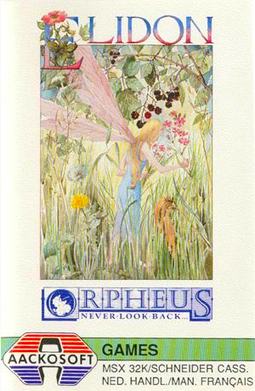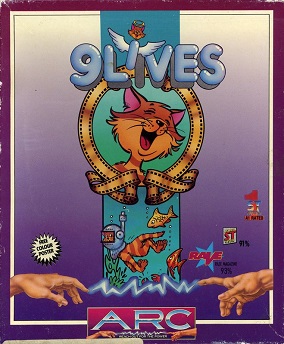
Rick Dangerous is a platform game developed by Core Design for the Acorn Archimedes, Amiga, Atari ST, Amstrad CPC, ZX Spectrum, Commodore 64, and MS-DOS. The game was released in 1989 and published by MicroProse on the Firebird Software label in the UK, and on the MicroPlay label in America. It was also published in Spain by Erbe Software. Later, it was released with two other games, Stunt Car Racer and MicroProse Soccer, on the Commodore 64 Powerplay 64 cartridge. The game was followed by a sequel, Rick Dangerous 2, in 1990. Loosely based on the Indiana Jones film franchise, the game received mixed reviews from critics.
In video games, a power-up is an object that adds temporary benefits or extra abilities to the player character as a game mechanic. This is in contrast to an item, which may or may not have a permanent benefit that can be used at any time chosen by the player. Although often collected directly through touch, power-ups can sometimes only be gained by collecting several related items, such as the floating letters of the word 'EXTEND' in Bubble Bobble. Well known examples of power-ups that have entered popular culture include the power pellets from Pac-Man and the Super Mushroom from Super Mario Bros., which ranked first in UGO Networks' Top 11 Video Game Powerups.

Gauntlet II is a 1986 arcade game produced by Atari Games that serves as the immediate sequel to the original Gauntlet, which was released the previous year. Like its predecessor, Gauntlet II is a fantasy-themed top down dungeon crawler game and was released as a dedicated cabinet, as well as a conversion kit, both available in 2-player and 4-player versions.

Knight Lore is a 1984 action-adventure game developed and published by Ultimate Play the Game, and written by company founders Chris and Tim Stamper. The game is known for its use of isometric graphics, which it further popularized in video games. In Knight Lore, the player character Sabreman has forty days to collect objects throughout a castle and brew a cure to his werewolf curse. Each castle room is depicted in monochrome on its own screen and consists of blocks to climb, obstacles to avoid, and puzzles to solve.
Newsfield Publications Ltd was a British magazine publisher during the 1980s and early 1990s.

Citadel is a computer game developed by Michael Jakobsen for the BBC Micro, and released by Superior Software in 1985. It was also ported to the Acorn Electron. Centred around a castle, this platform game with some puzzle-solving elements requires players to find five hidden crystals and return them to their rightful place. It also features some outside areas external to the castle.

Head Over Heels is an action-adventure video game released by Ocean Software in 1987 for several 8-bit home computers. It uses an isometric engine that is similar to the Filmation technique first developed by Ultimate Play the Game.

Star Goose is a vertically scrolling shooter that was published for the Amiga, Atari ST, and MS-DOS by Logotron in 1988. The player controls Scouser-Gitt, who pilots the eponymous Star Goose, a vessel that has been commissioned to scour the planet Nom and collect 48 crystals. Players must collect all six crystals in each of the game's eight levels to advance, while at the same time avoiding or destroying enemies and maintaining their shield, ammunition, and fuel levels. The game's surfaces are contoured, which affects the way that bullets travel, and contain tunnels that switch modes to a three-dimensional perspective where the player can replenish their resources.

Aaargh! is a single-player action video game in which the player controls a giant monster with the goal of obtaining eggs by destroying buildings in different cities across a lost island. It was designed for Mastertronic's Arcadia Systems, an arcade machine based on the custom hardware of the Amiga, and was released in 1987. It was ported to a range of other platforms and released on these across 1988 and 1989. Electronic Arts distributed the Amiga version of the game.

The Trap Door is a video game published for the ZX Spectrum in 1986 by Piranha Software and ported to the Amstrad CPC and Commodore 64 by Five Ways Software. It was written by Don Priestley and based on the British children's television show of the same name.

Obsidian is an action-adventure computer game for the Amstrad CPC personal computer published by Artic Computing in 1986. The game is set on the titular space station located within the centre of an asteroid, which is out of control and drifting towards a black hole. The player must guide an astronaut with a jet pack around the station and re-activate its engine shields to prevent the Obsidian's destruction. This involves collecting items and using them to solve puzzles, while avoiding the Obsidian's reactivated security systems.

Aliens is a 1990 run and gun video game developed and published for arcades by Konami. It is based on the 1986 film of the same title. Two players can play the game cooperatively in addition to single-player.

Barbarian II: The Dungeon of Drax is a video game first published in 1988 for various home computers. It was released as Axe of Rage in North America. The game is the sequel to Barbarian: The Ultimate Warrior, which was published in 1987. In Barbarian II, the player controls a princess or barbarian character, exploring the game world to locate and defeat an evil wizard. The game's plot is an extension of its predecessor, although the gameplay is different. While the first game offers two players the opportunity for virtual head-to-head combat, the second is a single-player beat 'em up with fewer fighting moves. It uses a flip-screen style instead of scrolling.

Red Moon is the second game in the Time and Magik trilogy.

Cloud Kingdoms is a puzzle game published by Millennium Interactive for the Amiga, Atari ST, Commodore 64, and MS-DOS in 1990. The player controls Terry, a green bouncing sphere, on a quest to recover his magic crystals that have been stolen by Baron von Bonsai. To do so, he must travel through the eponymous Cloud Kingdoms, avoiding enemies and hazards while collecting all of the crystals within the game's time limit. The game was developed by Dene Carter at Logotron, with sounds and music composed by David Whittaker.

Soft & Cuddly is a horror action-adventure game released for the ZX Spectrum home computer. It was developed by John George Jones and published by The Power House in September 1987 in the United Kingdom and in early 1988 in Spain. The player assumes the role of a man armed with a laser gun and a jet pack, whose mother, the Android Queen, has been dismembered. The player's task is to locate the scattered body parts of the Android Queen and sew her back together.

Elidon is a 1985 action game developed and published by Orpheus for the Amstrad CPC, Commodore 64, and MSX computers.

Swords and Sorcery is a fantasy role playing video game developed and published by Personal Software Services. It was released exclusively in the United Kingdom for the ZX Spectrum in 1985 and the Amstrad CPC in 1986. The game contains elements of dungeon crawling and revolves around a customisable player-character navigating through catacombs in order to secure a large wealth of treasure, whilst simultaneously collecting seven pieces of sacred armour.

Friday the 13th: The Computer Game is the first game adaptation based on the films of the same name. It was released in 1986 by Domark for the Amstrad CPC, Commodore 64, and ZX Spectrum. The game was released on floppy diskette and cassette tape. The player's goal is to find and kill Jason, while making sure their friends or they themselves are not killed by Jason.

9 Lives is a 1990 platform video game released for the Amiga and Atari ST developed by ARC, a software division of Atari. The player takes the role of Bob Cat, who must rescue Claudette from a mad scientist who kidnapped her.


















